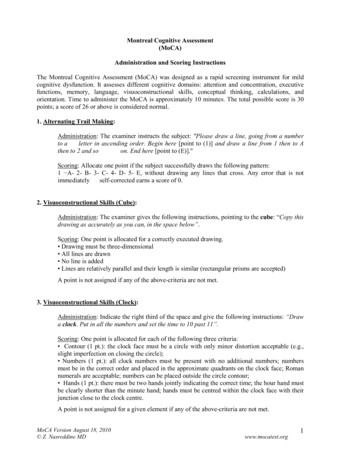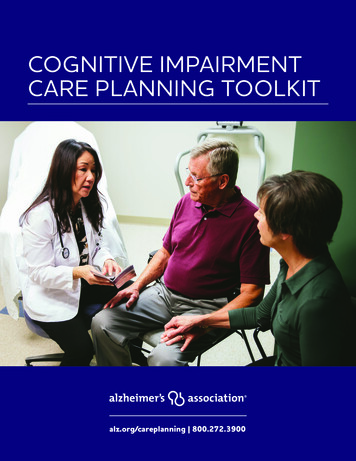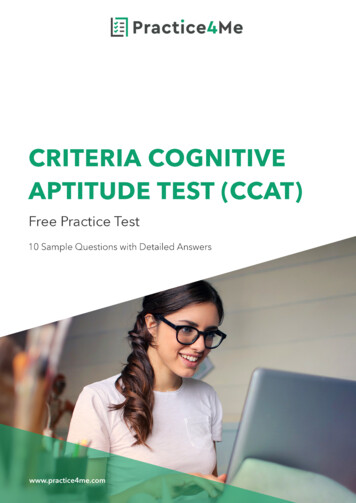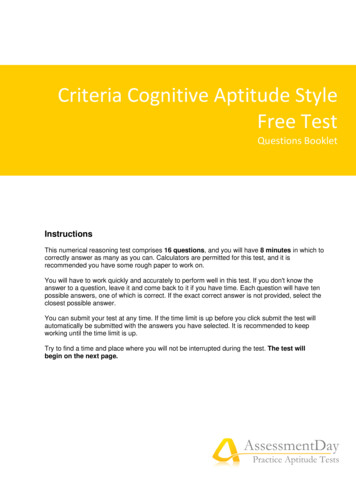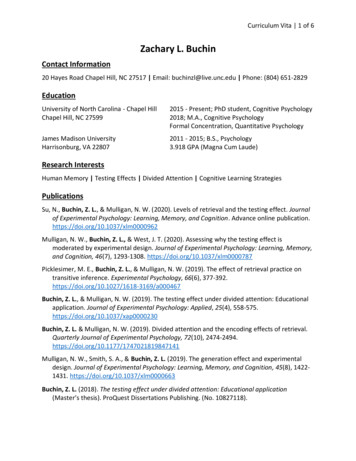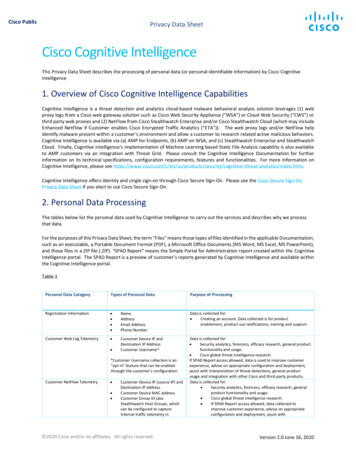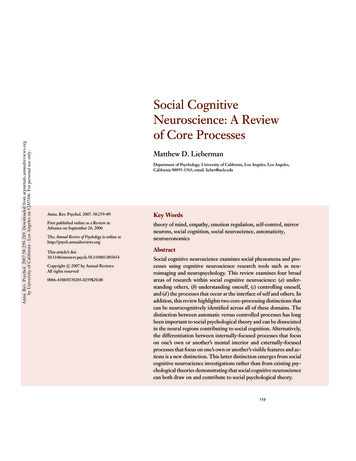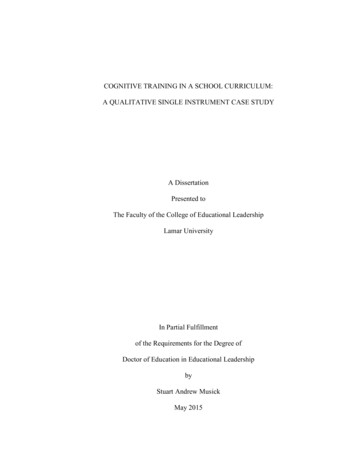
Transcription
Department of Behavioral PsychologyThe Role of Cognitive-Behavioral Interventionin Pediatric ConcussionLindsay Cirincione, Psy.D.Pediatric Psychology Consultation ServiceDepartment of Behavioral Psychology, Kennedy Krieger InstituteDepartment of Psychiatry & Behavioral SciencesJohns Hopkins University, School of Medicinewww.kennedykrieger.org
Overview Overview of Concussion Define Cognitive Behavioral Therapy Review the evidence base for CBT and concussionsymptoms Overview of intervention Introduce a model of incorporating CBT into concussiontreatment Implicationswww.kennedykrieger.org
What is a Concussion CDC Definition– “a disruption in the normal function of the brain that can becaused by a bump, blow, or jolt to the head, or penetrating headinjury” Concussion Mild Traumatic Brain Injury (mTBI)www.kennedykrieger.org
Sports & Recreation Related Concussion in YouthBryan et al., (2016)www.kennedykrieger.org
Concussion Symptom Domains Headache Dizziness Balance Nausea Visual Anxiety Low mood Attention Processing speed MemoryPhysicalCognitiveEmotionalSleep/Energy Hypersomnia Hyposomnia Drowsinesswww.kennedykrieger.org
Biopsychosocial Approach to UnderstandingConcussionYeates & Taylor (2005)www.kennedykrieger.org
What is Cognitive Behavioral Therapy? (CBT) A form of psychological intervention Helps patients identify and treat unhelpful thoughts,behaviors, and emotions In the medical setting, CBT is focused on treatingthoughts, behaviors, and emotions which are negativelyimpacting coping, recovery, and daily functioningwww.kennedykrieger.org
What is Cognitive Behavioral Therapy?(CBT)Situationsomething happens*Adapted from www.therapistaid.comThoughtEmotionBehaviorthe situation isinterpretedA feeling occurs as aresult of the thoughtAn action in responseto the emotionwww.kennedykrieger.org
“But I Don’t Need Therapy!”Why CBT for Pediatric Concussion? Psychological and behavioral symptoms after concussionare NORMAL !– Additionally, up to 1/3 of youth have psychological or behavioralsymptoms which extend beyond the initial recovery period1 Incorporating CBT into multi-disciplinary treatment isideal and can result in2:– Better overall functioning– Decreased depression/anxiety– Decrease in medical utilization The challenge lies in de-stigmatizing CBT and makingservices accessible1.2.CDC, 2018Conboy et al., 1986, Mateer, et al., 2005, Wilkins, et al., 2014, Moore et al., 2014, Tiresky et al., 2005www.kennedykrieger.org
What do we know?www.kennedykrieger.org
Post-traumatic Headache (PTH) One of the most common symptoms after concussion May not respond to medication alone Unresolved PTH can contribute to1:–––––1.Cognitive difficultyDisrupted daily functioningSleep disturbancesDecreased quality of lifeBehavioral responses that inhibit recoveryTaylor, et al., 2007, Zasler, 2015, Martelli et al., 2007www.kennedykrieger.org
Post-traumatic Headache (PTH) Non pharmacological treatment is beneficial 1––––BiofeedbackCBTStress ManagementRelaxation There is a greater need for alternative pain managementfor children.2– In fact, they may be more responsive to it!31.2.Martelli et al., 1999, Zasler, 2015Branson & Craig, 1987, Dunn-Geier et al., 1986, Bursch et al., 1998www.kennedykrieger.org
Sleep Among the most common symptoms of concussion1 CBT for sleep is well established in the pediatricpopulation and is often the treatment of choice2 Effective interventions3––––1.2.3.Stimulus controlSleep restrictionSleep hygieneRelaxationJaffe et al., 2015Kuhn & Elliott, 2003Thaxton & Patel, 2007, Oullet & Morin, 2004, Jaffe et al., 2045www.kennedykrieger.org
Mood Symptoms of depression and anxiety are common1 andcan increase complaints of cognitive and other postconcussive symptoms2 In adults, mood symptoms can matter more than theinjury itself when it comes to recovery trajectory3 Mood symptoms can impact pain experience, sleep, anddaily functioning1.2.3.Conder & Conder, 2015Hou et al., 2012, Silverberg & Iverson, 2011, Ponsford et al, 2012, Grubenhoff et al, 2016Mooney et al., 2005www.kennedykrieger.org
Return to Learn/Play Cycle of pain and inactivity– “Decreased activity in response [to pain], can prevent normalrestoration of function; perpetuate painful experience; and, incyclic disability-producing fashion, reinforce avoidance, inactivity,and increased pain.” (Martelli et al., 1999)PainConcussionHabituationto er.org
Return to Learn/Play Pediatric patients often find themselves in either a stateof inactivity or over-activity– Both can increase pain complaints and prolong recovery1 This is particularly important when considering return toschool/sports1.Hou et al., 2012www.kennedykrieger.org
Family Coping Family coping can promote or inhibit recovery Kids need family support to implement treatmentinterventions Poor family coping and parent distress can contribute topoor outcomes in pediatric concussion1 Positive family interactions around injury can supportsymptom management and coping2 CBT Family Oriented Treatment1– Altering unhelpful responses to pain– Supporting structured return to activity– Reinforcement of healthy behaviors1.2.McNally et al., 2013, Olsson et al., 2013Conder & Concer, 2015, Taylor et al., 2007www.kennedykrieger.org
CBT Intervention: What is it?What it’s notwww.kennedykrieger.org
Intervention – Behavioral Pain Management Diaphragmatic BreathingProgressive Muscle RelaxationGuided ImageryPatients are provided with tools for home practiceIndividualized preferred strategies are built upon overtimewww.kennedykrieger.org
Intervention - Sleep Structuring evenings and bedtimesEducation on healthy sleep habitsScheduling appropriate nap and wake timesFamilies are asked to incorporate:––––Consistent bedtimeLimiting electronic use before bedUsing bed only for sleepEngaging in relaxation prior to bedtimewww.kennedykrieger.org
Intervention – Activity Pacing Daily schedules for school and extracurricular activitiesTime management strategiesScheduling structured breaks during demanding activitiesDecreasing physical and cognitive accommodations overtimewww.kennedykrieger.org
Intervention – Behavioral Activation Increasing pleasurable activities and approved exercise Structuring daily activity, requiring increasing effort overtime Identifying pleasurable activities for promotion of positivemood/coping Examining thought patterns around pain and shifting tomore helpful ways of thinkingwww.kennedykrieger.org
Intervention - Mood Participating in positive activitiesPromoting social engagementIdentifying/using coping strategiesExploring ways to adjust peer interactionsChallenging unhelpful thinking patternswww.kennedykrieger.org
Intervention – Executive Functioning Organizational strategiesfor balancing makeupwork Strategies forcommunicating needsand structuringexpectations withteacherswww.kennedykrieger.org
Intervention – Supporting Adherence Strategies/resources for tracking hydration and nutrition Establishing reinforcement programs for medicationadherence Increasing family support and access to medical treatmentteamwww.kennedykrieger.org
Intervention – Family Coping Parent education on how to respond to pain symptoms Focus on reinforcing daily functioning and promotingsmall gains Referrals for appropriate support when caregivers are inneed Reviewing skills/strategies with caregivers after everyindividual sessionwww.kennedykrieger.org
A model for CBT in Concussion Treatment Clinic Setting––––Outpatient tertiary careAll patients assessed by Nursing, Medicine, and NeuropsychologyPatients are referred for CBT based on presenting concernsPatients receive up to four CBT sessions targeted toward treatingacute concerns and speeding re-integration to daily life– If further intervention is warranted, patients are referred foroutpatient therapy with pediatric psychology providerswww.kennedykrieger.org
A model for CBT in Concussion Treatmentwww.kennedykrieger.org
A model for CBT in Concussion TreatmentReferral Concerns40% of leepTraumaBehaviorwww.kennedykrieger.org
A model for CBT in Concussion Treatmentwww.kennedykrieger.org
Conclusions Mood and behavioral symptoms are a normal part ofconcussion recovery CBT is recommended in the multi-disciplinary treatmentof concussion CBT is effective in treating a number of concussion-relatedsymptoms CBT can help to speed recovery and prevent lingeringsymptoms It is possible to incorporate CBT in the multi-disciplinarytreatment of concussion with minimal burden to patients,families, and treatment team members.www.kennedykrieger.org
Thank you for your attentionLindsay Cirincione, Psy.D.cirincione@kennedykrieger.orgConcussion Clinic:443-923-9400Pediatric Psychology Consultation Service443-923-2900Special thanks to:Dr. Beth SlomineDr. Stacy SuskauerKKI Concussion Teamwww.kennedykrieger.org
Department of Behavioral Psychology. The Role of Cognitive-Behavioral Intervention in Pediatric Concussion. Lindsay Cirincione, Psy.D. Pediatric Psychology Consultation Service. Department of Behavioral Psychology, Kennedy Krieger Institute. Department of Psychiatry & Behavioral Sciences. Johns Hopkins University, School of Medicine

